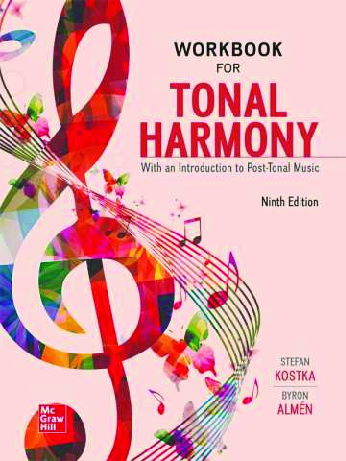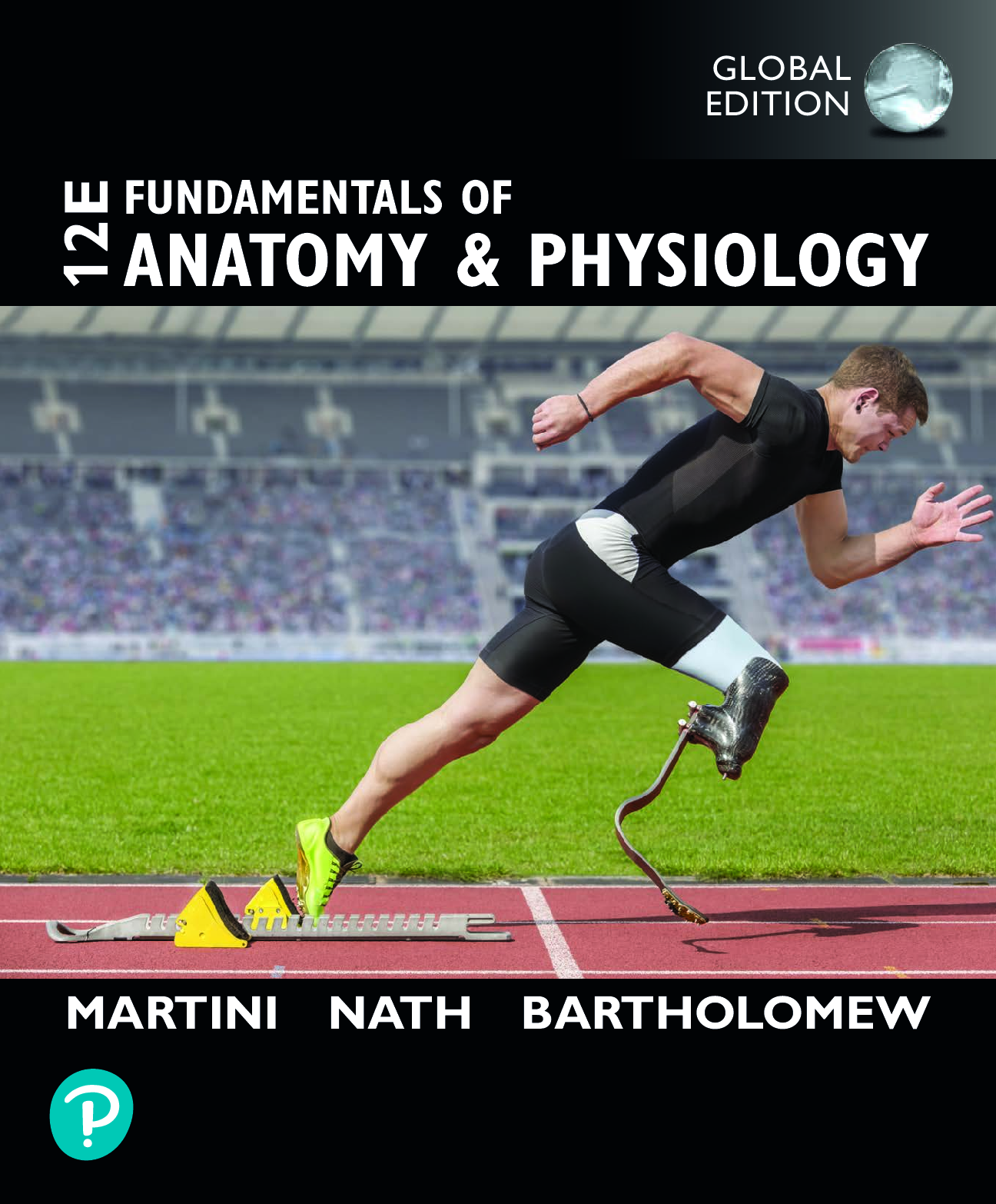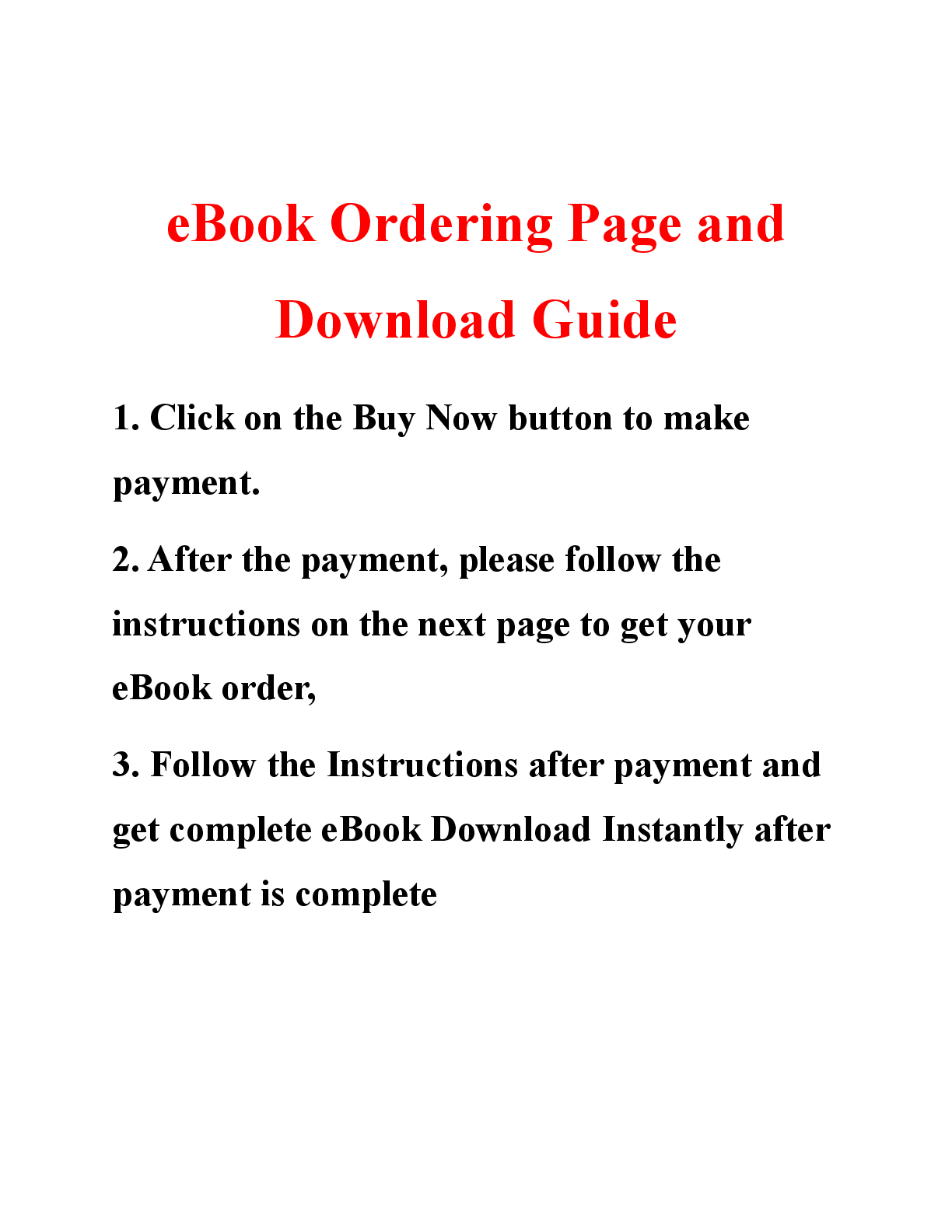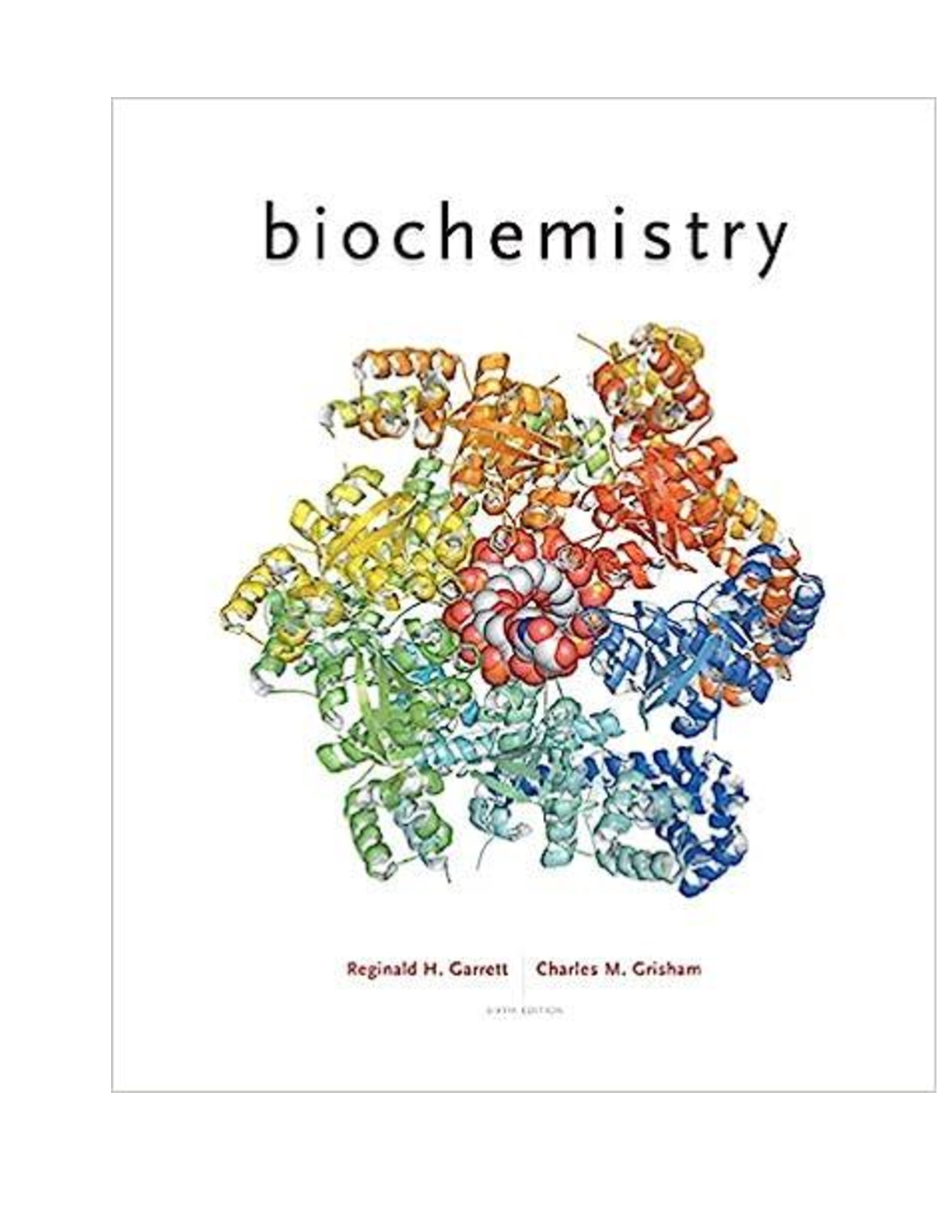BioChemistry > eBook-PDF > eBook for Biochemistry 6th Edition By Reginald H. Garrett, Charles M. Grisham (All)
eBook for Biochemistry 6th Edition By Reginald H. Garrett, Charles M. Grisham
Document Content and Description Below
eBook for Biochemistry 6th Edition By Reginald H. Garrett; Charles M. Grisham Get all 32 Chapters eBook Pdf. Detailed Contents Preface Part I Molecular Components of Cells Ch 1 The Facts of L... ife: Chemistry Is the Logic of Biological Phenomena 1.1 What Are the Distinctive Properties of Living Systems? 1.2 What Kinds of Molecules Are Biomolecules? 1.3 What Is the Structural Organization of Complex Biomolecules? 1.4 How Do the Properties of Biomolecules Reflect Their Fitness to the Living Condition? 1.5 What Are the Organization and Structure of Cells? 1.6 What Are Viruses? SUMMARY Foundational Biochemistry PROBLEMS Further Reading Ch 2 Water: The Medium of Life 2.1 What Are the Properties of Water? 2.2 What Is pH? 2.3 What Are Buffers, and What Do They Do? 2.4 What Properties of Water Give It a Unique Role in the Environment? SUMMARY Foundational Biochemistry PROBLEMS Further Reading Ch 3 Thermodynamics of Biological Systems 3.1 What Are the Basic Concepts of Thermodynamics? 3.2 What Is the Effect of Concentration on Net Free Energy Changes? 3.3 What Is the Effect of pH on Standard-State Free Energies? 3.4 What Can Thermodynamic Parameters Tell Us About Biochemical Events? 3.5 What Are the Characteristics of High-Energy Biomolecules? 3.6 What Are the Complex Equilibria Involved in AT P Hydrolysis? 3.7 Why Are Coupled Processes Important to Living Things? 3.8 What Is the Daily Human Requirement for AT P? 3.9 What Are Reduction Potentials, and How Are They Used to Account for Free Energy Changes in Redox SUMMARY Foundational Biochemistry PROBLEMS Further Reading Ch 4 Amino Acids and the Peptide Bond 4.1 What Are the Structures and Properties of Amino Acids? 4.2 What Are the Acid–Base Properties of Amino Acids? 4.3 What Reactions Do Amino Acids Undergo? 4.4 What Are the Optical and Stereochemical Properties of Amino Acids? 4.5 What Are the Spectroscopic Properties of Amino Acids? 4.6 How Are Amino Acid Mixtures Separated and Analyzed? 4.7 What Is the Fundamental Structural Pattern in Proteins? SUMMARY Foundational Biochemistry PROBLEMS Further Reading Ch 5 Proteins: Their Primary Structure and Biological Functions 5.1 What Architectural Arrangements Characterize Protein Structure? 5.2 How Are Proteins Isolated and Purified from Cells? 5.3 How Is the Amino Acid Analysis of Proteins Performed? 5.4 How Is the Primary Structure of a Protein Determined? 5.5 What Is the Nature of Amino Acid Sequences? 5.6 Can Polypeptides Be Synthesized in the Laboratory? 5.7 Do Proteins Have Chemical Groups Other Than Amino Acids? 5.8 What Are the Many Biological Functions of Proteins? 5.9 What Is the Proteome and What Does It Tell Us? SUMMARY Foundational Biochemistry PROBLEMS Further Reading Ch 6 Proteins: Secondary, Tertiary, and Quaternary Structure 6.1 What Noncovalent Interactions Stabilize the Higher Levels of Protein Structure? 6.2 What Role Does the Amino Acid Sequence Play in Protein Structure? 6.3 What Are the Elements of Secondary Structure in Proteins, and How Are They Formed? 6.4 How Do Polypeptides Fold into Three-Dimensional Protein Structures? 6.5 How Do Protein Subunits Interact at the Quaternary Level of Protein Structure? SUMMARY Foundational Biochemistry PROBLEMS Further Reading Ch 7 Carbohydrates and the Glycoconjugates of Cell Surfaces 7.1 How Are Carbohydrates Named? 7.2 What Are the Structure and Chemistry of Monosaccharides? 7.3 What Are the Structure and Chemistry of Oligosaccharides? 7.4 What Are the Structure and Chemistry of Polysaccharides? 7.5 What Are Glycoproteins, and How Do They Function in Cells? 7.6 How Do Proteoglycans Modulate Processes in Cells and Organisms? 7.7 Do Carbohydrates Provide a Structural Code? SUMMARY Foundational Biochemistry PROBLEMS Further Reading Ch 8 Lipids 8.1 What Are the Structures and Chemistry of Fatty Acids? 8.2 What Are the Structures and Chemistry of Triacylglycerols? 8.3 What Are the Structures and Chemistry of Glycerophospholipids? 8.4 What Are Sphingolipids, and How Are They Important for Higher Animals? 8.5 What Are Waxes, and How Are They Used? 8.6 What Are Terpenes, and What Is Their Relevance to Biological Systems? 8.7 What Are Steroids, and What Are Their Cellular Functions? 8.8 How Do Lipids and Their Metabolites Act as Biological Signals? 8.9 What Can Lipidomics Tell Us about Cell, Tissue, and Organ Physiology? SUMMARY Foundational Biochemistry PROBLEMS Further Reading Ch 9 Membranes and Membrane Transport 9.1 What Are the Chemical and Physical Properties of Membranes? 9.2 What Are the Structure and Chemistry of Membrane Proteins? 9.3 How Are Biological Membranes Organized? 9.4 What Are the Dynamic Processes That Modulate Membrane Function? 9.5 How Does Transport Occur Across Biological Membranes? 9.6 What Is Passive Diffusion? 9.7 How Does Facilitated Diffusion Occur? 9.8 How Does Energy Input Drive Active Transport Processes? 9.9 How Are Certain Transport Processes Driven by Light Energy? 3159.10 How Is Secondary Active Tran SUMMARY Foundational Biochemistry PROBLEMS Further Reading Ch 10 Nucleotides and Nucleic Acids 10.1 What Are the Structure and Chemistry of Nitrogenous Bases? 10.2 What Are Nucleosides? 10.3 What Are the Structure and Chemistry of Nucleotides? 10.4 What Are Nucleic Acids? 10.5 What Are the Different Classes of Nucleic Acids? 10.6 Are Nucleic Acids Susceptible to Hydrolysis? SUMMARY Foundational Biochemistry PROBLEMS Further Reading Ch 11 Structure of Nucleic Acids 11.1 How Do Scientists Determine the Primary Structure of Nucleic Acids? 11.2 What Sorts of Secondary Structures Can Double-Stranded DNA Molecules Adopt? 11.3 Can the Secondary Structure of DNA Be Denatured and Renatured? 11.4 Can DNA Adopt Structures of Higher Complexity? 11.5 What Is the Structure of Eukaryotic Chromosomes? 11.6 Can Nucleic Acids Be Synthesized Chemically? 11.7 What Are the Secondary and Tertiary Structures of RNA? SUMMARY Foundational Biochemistry PROBLEMS Further Reading Ch 12 Recombinant DNA , Cloning, Chimeric Genes, and Synthetic Biology 12.1 What Does It Mean "To Clone"? 12.2 What Is a DNA Library? 12.3 Can the Cloned Genes in Libraries Be Expressed? 12.4 How Is RNA Interference Used to Reveal the Function of Genes? 12.5 How Does High-Throughput Technology Allow Global Study of Millions of Genes or Molecules at Onc 12.6 Is It Possible to Make Directed Changes in the Heredity of an Organism? 12.7 What Is the New Field of Synthetic Biology? SUMMARY Foundational Biochemistry PROBLEMS Further Reading Part II Protein Dynamics Ch 13 Enzymes-Kinetics and Specificity 13.1 What Characteristic Features Define Enzymes? 13.2 Can the Rate of an Enzyme-Catalyzed Reaction Be Defined in a Mathematical Way? 13.3 What Equations Define the Kinetics of Enzyme Catalyzed Reactions? 13.4 What Can Be Learned from the Inhibition of Enzyme Activity? 13.5 What Is the Kinetic Behavior of Enzymes Catalyzing Bimolecular Reactions? 13.6 How Can Enzymes Be So Specific? 13.7 Are All Enzymes Proteins? 13.8 Is It Possible to Design an Enzyme to Catalyze Any Desired Reaction? SUMMARY Foundational Biochemistry PROBLEMS Further Reading Ch 14 Mechanisms of Enzyme Action 14.1 What Are the Magnitudes of Enzyme-Induced Rate Accelerations? 14.2 What Role Does Transition-State Stabilization Play in Enzyme Catalysis? 14.3 How Does Destabilization of ES Affect Enzyme Catalysis? 14.4 How Tightly Do Transition-State Analogs Bind to the Active Site? 14.5 What Are the Mechanisms of Catalysis? 14.6 What Can Be Learned from Typical Enzyme Mechanisms? SUMMARY Foundational Biochemistry PROBLEMS Further Reading Ch 15 Enzyme Regulation 15.1 What Factors Influence Enzymatic Activity? 15.2 What Are the General Features of Allosteric Regulation? 15.3 Can Allosteric Regulation Be Explained by Conformational Changes in Proteins? 15.4 What Kinds of Covalent Modification Regulate the Activity of Enzymes? 15.5 Is the Activity of Some Enzymes Controlled by Both Allosteric Regulation and Covalent Modificat SUMMARY Foundational Biochemistry PROBLEMS Further Reading Ch 16 Molecular Motors 16.1 What Is a Molecular Motor? 16.2 What Is the Molecular Mechanism of Muscle Contraction? 16.3 What Are the Molecular Motors That Orchestrate the Mechanochemistry of Microtubules? 16.4 How Do Molecular Motors Unwind DNA? 16.5 How Do Bacterial Flagella Use a Proton Gradient to Drive Rotation? Part III Metabolism and Its Regulation Ch 17 Metabolism: An Overview 17.1 Is Metabolism Similar in Different Organisms? 17.2 What Can Be Learned from Metabolic Maps? 17.3 How Do Anabolic and Catabolic Processes Form the Core of Metabolic Pathways? 17.4 What Experiments Can Be Used to Elucidate Metabolic Pathways? 17.5 What Can the Metabolome Tell Us about a Biological System? 17.6 What Food Substances Form the Basis of Human Nutrition? SUMMARY Foundational Biochemistry PROBLEMS Further Reading Ch 18 Glycolysis 18.1 What Are the Essential Features of Glycolysis? 18.2 Why Are Coupled Reactions Important in Glycolysis? 18.3 What Are the Chemical Principles and Features of the First Phase of Glycolysis? 18.4 What Are the Chemical Principles and Features of the Second Phase of Glycolysis? 18.5 What Are the Metabolic Fates of NADH and Pyruvate Produced in Glycolysis? 18.6 How Do Cells Regulate Glycolysis? 18.7 Are Substrates Other Than Glucose Used in Glycolysis? 18.8 How Do Cells Respond to Hypoxic Stress? SUMMARY Foundational Biochemistry PROBLEMS Further Reading Ch 19 The Tricarboxylic Acid Cycle 19.1 What Is the Chemical Logic of the TCA Cycle? 19.2 How Is Pyruvate Oxidatively Decarboxylated to Acetyl-CoA? 19.3 How Are Two CO2 Molecules Produced from Acetyl-CoA? 19.4 How Is Oxaloacetate Regenerated to Complete the TCA Cycle? 19.5 What Are the Energetic Consequences of the TCA Cycle? 19.6 Can the TCA Cycle Provide Intermediates for Biosynthesis? 19.7 What Are the Anaplerotic, or "Filling Up," Reactions? 19.8 How Is the TCA Cycle Regulated? 19.9 Can Any Organisms Use Acetate as Their Sole Carbon Source? SUMMARY Foundational Biochemistry PROBLEMS Further Reading Ch 20 Electron Transport and Oxidative Phosphorylation 20.1 Where in the Cell Do Electron Transport and Oxidative Phosphorylation Occur? 20.2 How Is the Electron-Transport Chain Organized? 20.3 What Are the Thermodynamic Implications of Chemiosmotic Coupling? 20.4 How Does a Proton Gradient Drive the Synthesis of AT P? 20.5 What Is the P/O Ratio for Mitochondrial Oxidative Phosphorylation? 20.6 How Are the Electrons of Cytosolic NADH Fed into Electron Transport? 20.7 How Do Mitochondria Mediate Apoptosis? SUMMARY Foundational Biochemistry PROBLEMS Further Reading Ch 21 Photosynthesis 21.1 What Are the General Properties of Photosynthesis? 21.2 How Is Solar Energy Captured by Chlorophyll? 21.3 What Kinds of Photosystems Are Used to Capture Light Energy? 21.4 What Is the Molecular Architecture of Photosynthetic Reaction Centers? 21.5 What Is the Quantum Yield of Photosynthesis? 21.6 How Does Light Drive the Synthesis of AT P? 21.7 How Is Carbon Dioxide Used to Make Organic Molecules? 21.8 How Does Photorespiration Limit CO2 Fixation? SUMMARY Foundational Biochemistry PROBLEMS Further Reading Ch 22 Gluconeogenesis, Glycogen Metabolism, and the Pentose Phosphate Pathway 22.1 What Is Gluconeogenesis, and How Does It Operate? 22.2 How Is Gluconeogenesis Regulated? 22.3 How Are Glycogen and Starch Catabolized in Animals? 22.4 How Is Glycogen Synthesized? 22.5 How Is Glycogen Metabolism Controlled? 22.6 Can Glucose Provide Electrons for Biosynthesis? SUMMARY Foundational Biochemistry PROBLEMS Further Reading Ch 23 Fatty Acid Catabolism 23.1 How Are Fats Mobilized from Dietary Intake and Adipose Tissue? 23.2 How Are Fatty Acids Broken Down? 23.3 How Are Odd-Carbon Fatty Acids Oxidized? 23.4 How Are Unsaturated Fatty Acids Oxidized? 23.5 Are There Other Ways to Oxidize Fatty Acids? 23.6 What Are Ketone Bodies, and What Role Do They Play in Metabolism? SUMMARY Foundational Biochemistry PROBLEMS Further Reading Ch 24 Lipid Biosynthesis 24.1 How Are Fatty Acids Synthesized? 24.2 How Are Complex Lipids Synthesized? 24.3 How Are Eicosanoids Synthesized, and What Are Their Functions? 24.4 How Is Cholesterol Synthesized? 24.5 How Are Lipids Transported Throughout the Body? 24.6 How Are Bile Acids Biosynthesized? 24.7 How Are Steroid Hormones Synthesized and Utilized? SUMMARY Foundational Biochemistry PROBLEMS Further Reading Ch 25 Nitrogen Acquisition and Amino Acid Metabolism 25.1 Which Metabolic Pathways Allow Organisms to Live on Inorganic Forms of Nitrogen? 25.2 What Is the Metabolic Fate of Ammonium? 25.3 What Regulatory Mechanisms Act on Escherichia coli Glutamine Synthetase? 25.4 How Do Organisms Synthesize Amino Acids? 25.5 How Does Amino Acid Catabolism Lead into Pathways of Energy Production? SUMMARY Foundational Biochemistry PROBLEMS Further Reading Ch 26 Synthesis and Degradation of Nucleotides 26.1 Can Cells Synthesize Nucleotides? 26.2 How Do Cells Synthesize Purines? 26.3 Can Cells Salvage Purines? 26.4 How Are Purines Degraded? 26.5 How Do Cells Synthesize Pyrimidines? 26.6 How Are Pyrimidines Degraded? 26.7 How Do Cells Form the Deoxyribonucleotides That Are Necessary for DNA Synthesis? 26.8 How Are Thymine Nucleotides Synthesized? SUMMARY Foundational Biochemistry PROBLEMS Further Reading Ch 27 Metabolic Integration and Organ Specialization 27.1 Can Systems Analysis Simplify the Complexity of Metabolism? 27.2 What Underlying Principle Relates ATP Coupling to the Thermodynamics of Metabolism? 27.3 Is There a Good Index of Cellular Energy Status? 27.4 How Is Overall Energy Balance Regulated in Cells? 27.5 How Is Metabolism Integrated in a Multicellular Organism? 27.6 What Regulates Our Eating Behavior? 27.7 Can You Really Live Longer by Eating Less? SUMMARY Foundational Biochemistry PROBLEMS Further Reading Part IV Information Transfer Ch 28 DNA Metabolism: Replication, Recombination, and Repair 28.1 How Is DNAreplicated? 28.2 What Are the Functions of DNA Polymerases? 28.3 Why Are There So Many DNA Polymerases? 28.4 How Is DNAreplicated in Eukaryotic Cells? 28.5 How Are the Ends of Chromosomes Replicated? 28.6 How Are RNA Genomes Replicated? 28.7 How Is the Genetic Information Rearranged by Genetic Recombination? 28.8 Can DNA Be Repaired? 28.9 What Is the Molecular Basis of Mutation? SUMMARY Foundational Biochemistry PROBLEMS Further Reading Ch 29 Transcription and the Regulation of Gene Expression 29.1 How Are Genes Transcribed in Bacteria? 29.2 How Is Transcription Regulated in Bacteria? 29.3 How Are Genes Transcribed in Eukaryotes? 29.4 How Do Gene Regulatory Proteins Recognize Specific DNA Sequences? 29.5 How Are Eukaryotic Transcripts Processed and Delivered to the Ribosomes for Translation? 29.6 Can Gene Expression Be Regulated Once the Transcript Has Been Synthesized? 29.7 Can We Propose a Unified Theory of Gene Expression? SUMMARY Foundational Biochemistry PROBLEMS Further Reading Ch 30 Protein Synthesis 30.1 What Is the Genetic Code? 30.2 How Is an Amino Acid Matched with Its Proper tRNA? 30.3 What Are the Rules in Codon–Anticodon Pairing? 30.4 What Is the Structure of Ribosomes, and How Are They Assembled? 30.5 What Are the Mechanics of mRNA Translation? 30.6 How Are Proteins Synthesized in Eukaryotic Cells? SUMMARY Foundational Biochemistry PROBLEMS Further Reading Ch 31 Completing the Protein Life Cycle: Folding, Processing, and Degradation 31.1 How Do Newly Synthesized Proteins Fold? 31.2 How Are Proteins Processed Following Translation? 31.3 How Do Proteins Find Their Proper Place in the Cell? 31.4 How Does Protein Degradation Regulate Cellular Levels of Specific Proteins? SUMMARY Foundational Biochemistry PROBLEMS Further Reading Ch 32 The Reception and Transmission of Extracellular Information 32.1 What Are Hormones? 32.2 What Is Signal Transduction? 32.3 How Do Signal-Transducing Receptors Respond to the Hormonal Message? 32.4 How Are Receptor Signals Transduced? 32.5 How Do Effectors Convert the Signals to Actions in the Cell? 32.6 How Are Signaling Pathways Organized and Integrated? 32.7 How Do Neurotransmission Pathways Control the Function of Sensory Systems? SUMMARY Foundational Biochemistry PROBLEMS Further Reading Abbreviated Answers to Problems Index [Show More]
Last updated: 1 year ago
Preview 1 out of 1280 pages

Buy this document to get the full access instantly
Instant Download Access after purchase
Buy NowInstant download
We Accept:

Reviews( 0 )
$20.00
Can't find what you want? Try our AI powered Search
Document information
Connected school, study & course
About the document
Uploaded On
Oct 04, 2021
Number of pages
1280
Written in
Additional information
This document has been written for:
Uploaded
Oct 04, 2021
Downloads
1
Views
244
















